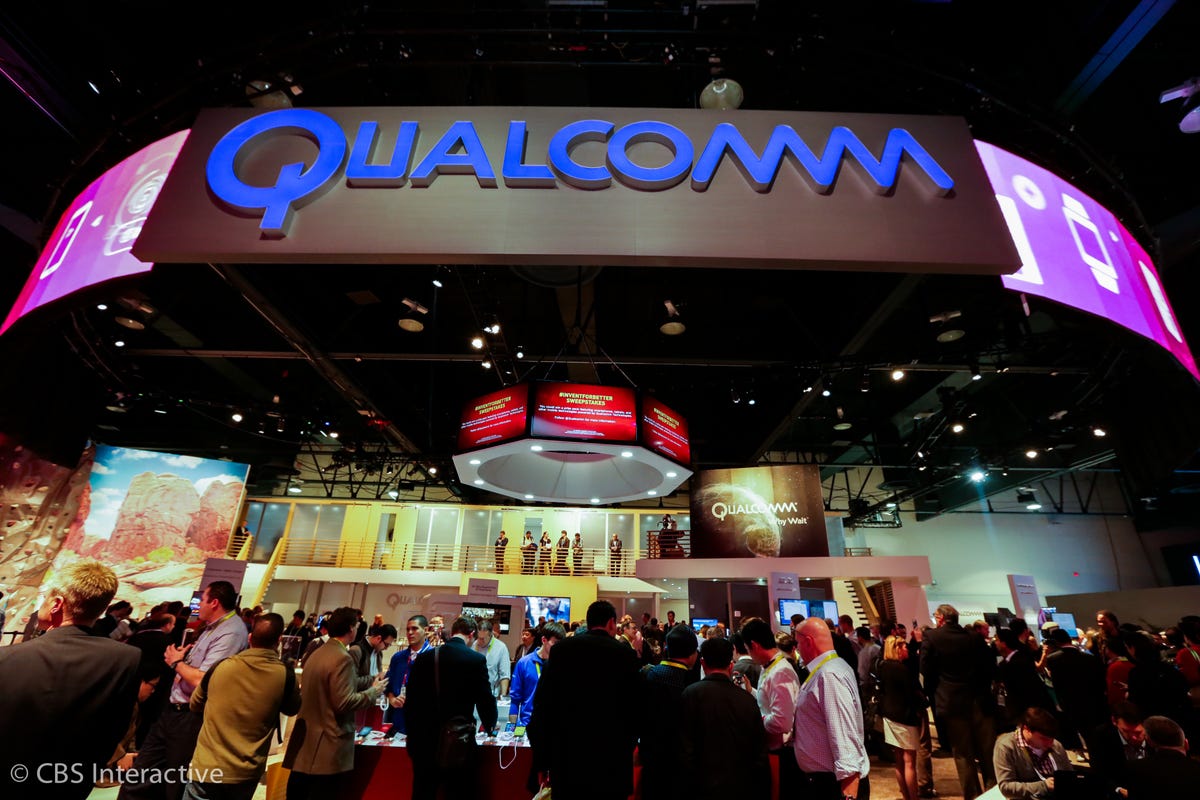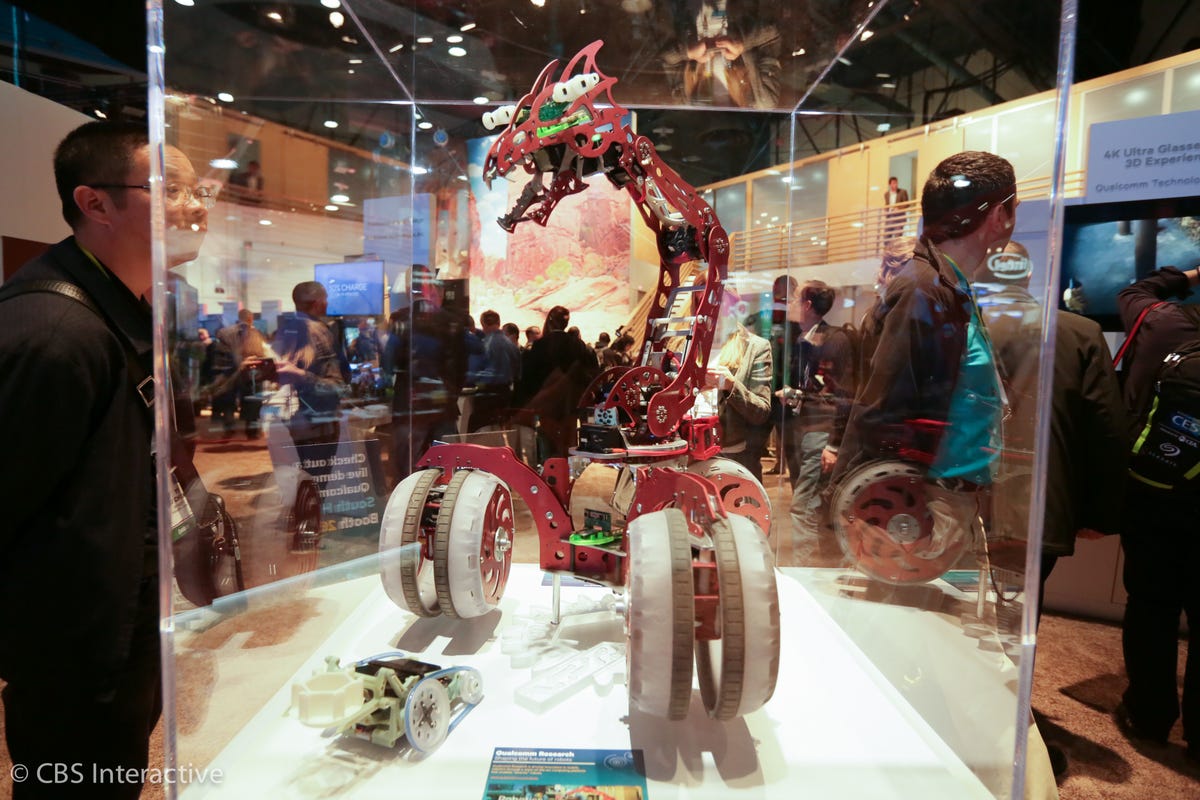
Sarah Tew/CNET
LAS VEGAS — The brightly colored Qualcomm booth at this year’s Consumer Electronics Show packed in a panoply of gadgets: There was a red-dragon robot, a blue connected car with Qualcomm’s logo splashed across the hood and disembodied mannequin hands in glass cases wearing a range of smartwatches.
As thousands of people walked through the loud and sprawling Las Vegas Convention Center — with Qualcomm’s space right in the middle of the chaos — Derek Aberle, the company’s president, sat in a quiet meeting room tucked in the back of the expansive booth to discuss his company’s strategies for 2015.
As the booth illustrated, Qualcomm — already the world’s biggest maker of mobile chips — is hoping to use its wealth of research in mobile devices to become the company powering wearables, robots, cars, medical technologies and more.


Josh Miller/CNET
“We look at it and say, OK, with a relatively small incremental investment and the right go-to-market,” Aberle said of Qualcomm’s push into new tech sectors, “we can capture a pretty big opportunity, just leveraging this massive investment we made because of the scale of the smartphone business.”
Qualcomm’s expansion effort comes as tech firms scramble to connect millions of objects to the Web — an idea known as the Internet of Things — creating vast new ground for chipmakers like Qualcomm to gain new business. While the Internet of Things area offers huge potential, its already invited plenty of competition from Qualcomm’s rivals. For example, fellow chipmaker Intel — whose booth was stationed right next to Qualcomm’s on the convention floor — constructed a booth just as broad and filled with all kinds of connected devices.
It’s clear why these companies are so keen to stake a claim in this area: the market for Internet of Things is expected to grow to $3.04 trillion by 2020, according to market research firm IDC.
While Qualcomm tries to capture a piece of all these new markets, the maker of Snapdragon mobile chips has been distracted by an ongoing investigation by Chinese regulators. Officials there have spent more than a year looking into whether the chipmaker’s lucrative licensing business runs afoul of the country’s anti-monopoly laws. Aberle couldn’t say when the investigation might be resolved, but he said it was unlikely any negative outcome out of China would — as some analysts predict — create a domino effect, with fines or new limitations spreading to more countries.
Qualcomm booth tour at CES 2015 (pictures)






Going big in auto and health care
Two main areas in the Internet of Things that Qualcomm will focus on this year will be automotive and wireless health, Aberle said. In automotive, the company will build upon its work connecting cars — such as with General Motor’s OnStar security and navigation system — and provide digital display panels and safety systems, such as cameras that can watch a driver’s face for fatigue and alert him when needed. Qualcomm’s work in auto will place it in direct competition with graphics-chip maker Nvidia, which is also making a big push in the sector.
“Your future cars will be the most advanced computers in the world,” Jen-Hsun Huang, CEO of Nvidia, told a crowd of hundreds at his company’s CES presentation, as he offered new ways his company would power automated driving and digital dashboard displays.
In the medical world, Qualcomm last week unveiled partnerships with drugstore chain Walgreens and drug maker Novartis, as it seeks to use its wireless technology to enable remote patient monitoring and speed up data collection in medical trials. Qualcomm hopes these technologies can help reduce health care costs while also offering more convenient service for patients, Aberle said.


Ben Fox Rubin/CNET
Company executives like to mention that they are already shipping their chips in wearables and other new connected devices, so their big push isn’t just talk. Qualcomm, however, faces the danger of spreading itself too thin across all these new markets. “We worry about that and we think a lot about that, and it just comes down to how you organize,” Aberle said.
He said the company will likely structure itself with a team focused on the main mobile business and separate teams working on spreading the core business’ technology to new areas. “We think we can do it in a way without detracting or distracting the teams from the core task at hand,” he added.
With smartphone growth slowing in mature markets, Qualcomm needs to uncover new places to sustain its expansion. The company already has relationships with the main smartwatches players — including Samsung, Sony and Apple — and already created chips that can fit in small devices and consume less power. Also, a deal to acquire British chipmaker CSR for $2.5 billion will give Qualcomm a strong portfolio of wireless Bluetooth technology — a critical piece for connecting objects and devices. Considering these factors, the company is well-positioned to grow in wearables and the Internet of Things — yet, that won’t be enough to ensure success.
“There isn’t an established leader,” IHS analyst Ian Fogg said of the Internet of Things space, so while Qualcomm has a good start, “other companies see the same opportunity.”
Uncertainty in China continues
As Qualcomm continues to move on its expansion plans, it’s still being hampered by a year-long investigation in China, the world’s biggest smartphone market by users and one of Qualcomm’s most important regions.
The chipmaker, which generated half of its $26.5 billion in fiscal 2014 revenue from China, is one of several multinational companies, including Microsoft and Daimler, that have faced scrutiny from China’s anti-monopoly regulator. Some businesses have complained that China is using its 2008 antitrust laws unfairly against foreign companies. Regardless of those claims, the investigation has been a drag on Qualcomm’s stock and business there.


Sarah Tew/CNET
The company’s stock over the past year is roughly flat, while the S&P 500 benchmark is up about 10 percent. Amid that weakness, the company said last month it would lay off about 600 employees, or about 2 percent of its total workforce. “China is clearly the near-term overhang on the company and the stock,” said Morningstar analyst Brian Colello.
Despite the current problems, Aberle voiced optimism about Qualcomm’s future in China, saying his company has been working in the country for more than 10 years and plans to keep up its relationship with local device makers and carriers to roll out high-speed 4G wireless access to the market. “We think there’s an opportunity to continue this win-win partnership, and that’s what we’ve been focusing on,” he said.
RELATED STORIES
- Qualcomm marches forward into the Internet of Things
- Qualcomm boosts the brains on its flagship Snapdragon 810 chip
- Qualcomm’s China troubles dampen earnings
Also, anti-monopoly laws vary from country to country, and so do patents, Aberle said, so it’s unlikely any fines or changes to Qualcomm’s China business will bleed into other regions. “Our belief is that what happens in China won’t necessarily then become a template for what happens in the rest of the world,” he said.
If Qualcomm isn’t hindered in China, it should be able to build up a strong 4G market position there, IHS’ Fogg said. But if it’s sidelined, he added, that could open the door for an Asian competitor like MediaTek or Spreadtrum.
Although Qualcomm’s future faces plenty of challenges, from Internet of Things competition to the China investigation, it has a big opportunity to place itself in a stronger position in 2015.
“There’s definitely understanding in the massive opportunity in wearables and IOT,” Fogg said, using the acronym for Internet of Things. “They’ve got a good basis from which to execute.”



